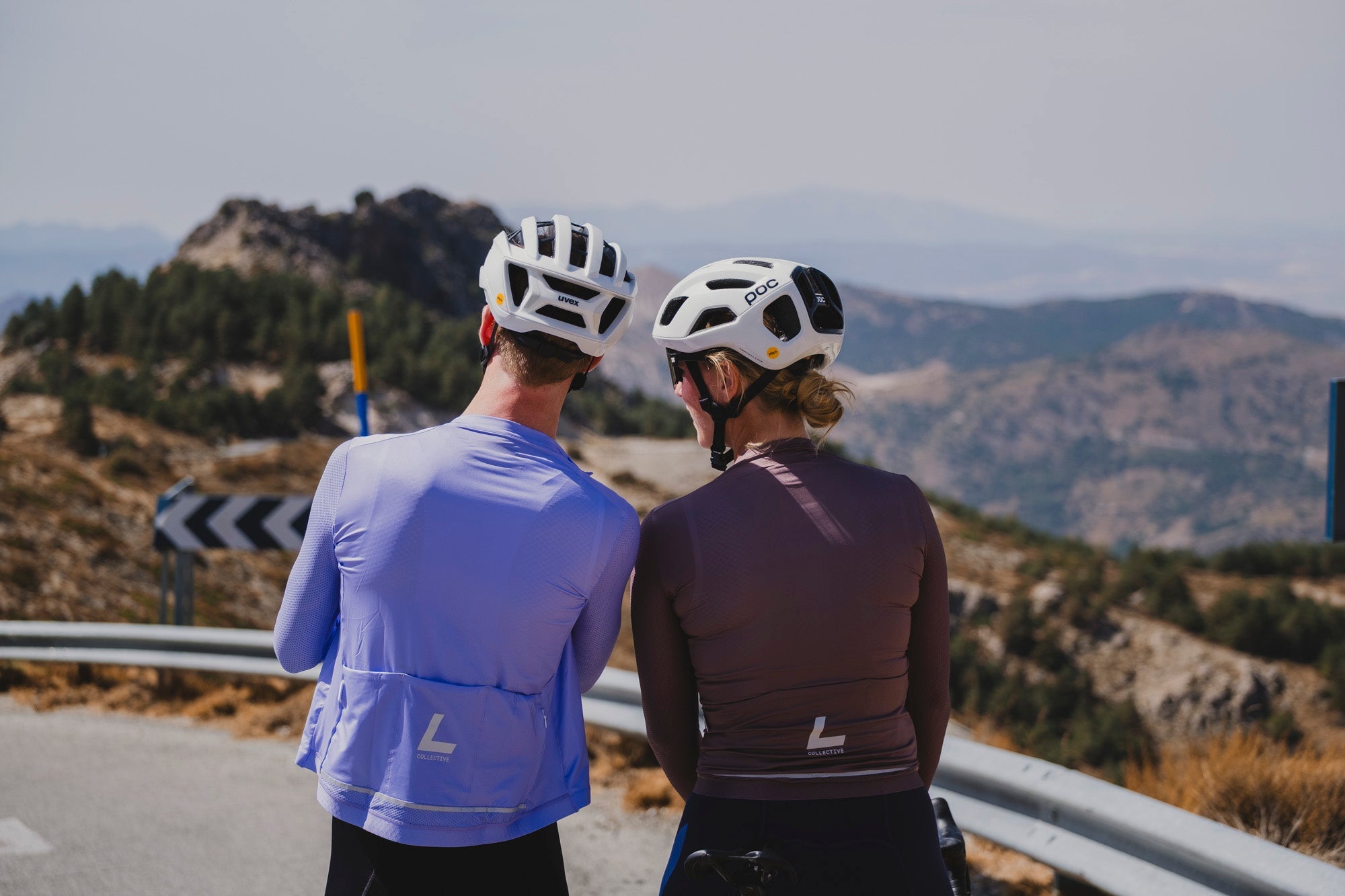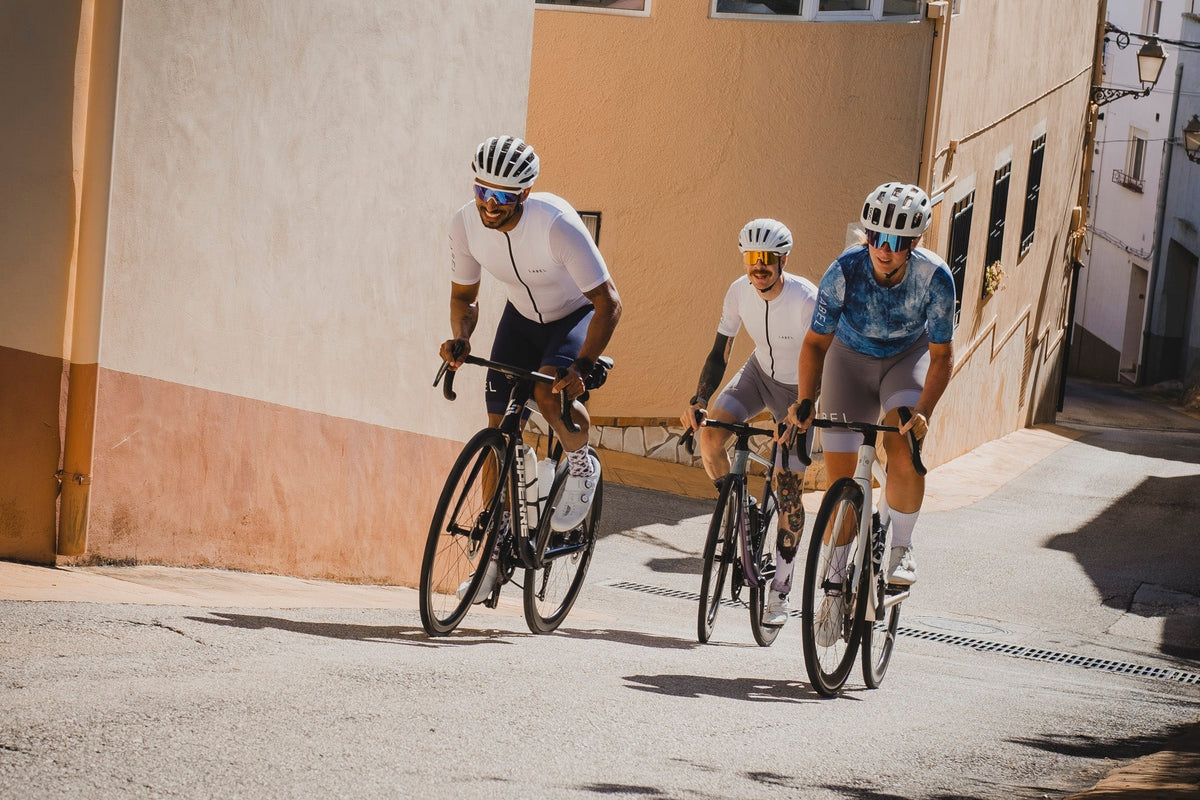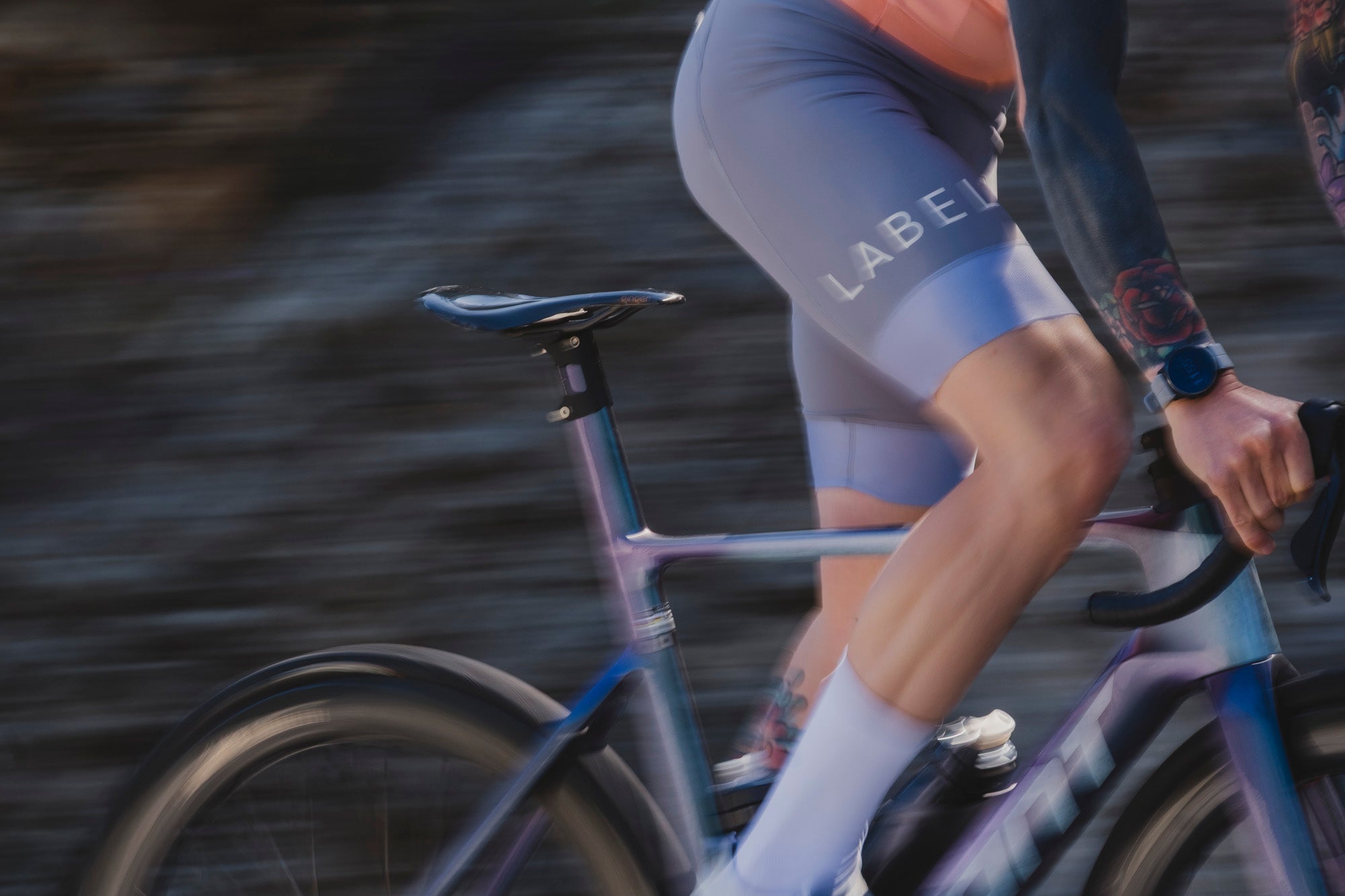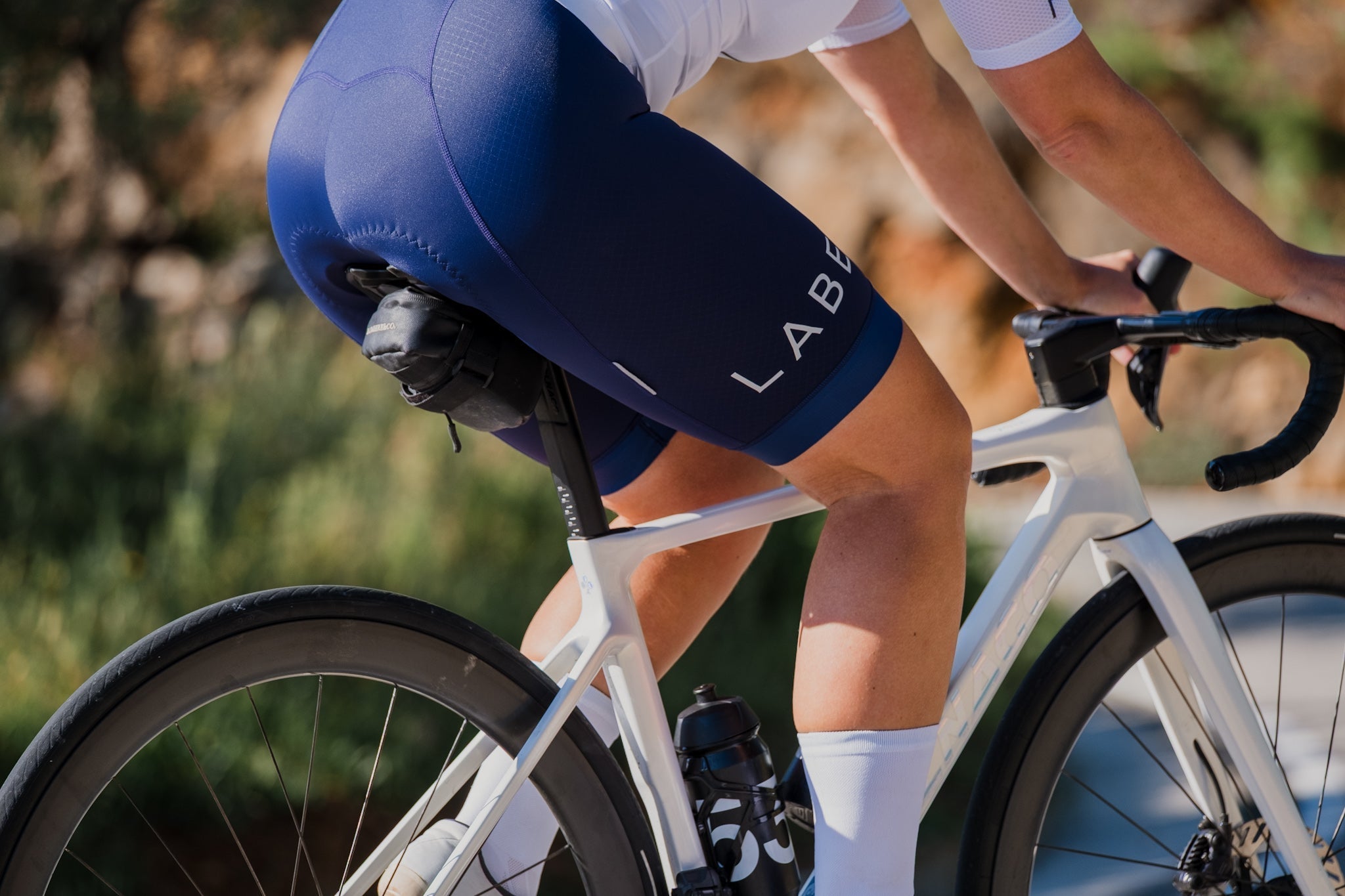
Cycling has its own unique language. This glossary will help you understand the key terms and phrases cyclists use.
A
Abandon:
When a cyclist stops racing due to injury, fatigue, or other reasons.
Aero:
Refers to streamlined designs or positions that reduce air resistance, making cycling faster and easier.
Aero bars:
Extensions added to handlebars that position a cyclist’s arms forward, significantly reducing wind resistance for faster riding.
Aero helmet:
Helmet shaped to minimize air drag, essential for time trials and triathlons.
Aerobic:
Exercise done at a pace allowing continuous oxygen supply, suitable for long distances.
Aero:
Equipment or riding positions that minimise wind drag getting you Aerodynamic
Alloy:
A mix of metals, typically referring to aluminium in cycling.
Alpe d’Huez:
Famous, challenging climb in the Tour de France known for steep gradients and 21 tight turns.
Aluminum:
Lightweight, strong, cost-effective metal frequently used for bike frames and components.
Anaerobic:
High-intensity exercise beyond the point of sustainable oxygen supply, only manageable for short durations.
Anti-zipper ripple:
Design that shortens the front of cycling jerseys to reduce fabric bulging, improving fit and aerodynamics.
Anquetil, Jacques:
First cyclist to win the Tour de France five times, known for his bold predictions and performance.
Apex:
Shortest, fastest line through a curve.
Arm warmers:
Sleeves worn on arms to keep warm, easily removable and packable during rides.
Attack:
A quick acceleration intended to break away from competitors.
Audax:
Long-distance group cycling at a steady pace, led by a designated captain, usually at 22.5 km/h.
Autobus:
Group of slower cyclists working together to finish within the stage’s time limit.
B
Bacon:
Cycling slang for scrapes, cuts, or abrasions from falls.
Bail:
To deliberately abandon the bike mid-accident to avoid injury.
Balaclava:
Headgear covering head and neck, used for warmth under helmets.
Bead:
Inner edge of a tyre fitting securely onto the wheel rim.
Bell lap:
Final lap indicated by a bell in races or laps with prizes.
Bibs:
Cycling shorts with shoulder straps, offering extra comfort by removing waistband pressure.
Biff:
Slang for falling off a bike.
Big ringing:
Riding using the largest front gear for maximum speed on flat or downhill roads.
Blocking:
Tactic of legally slowing rivals to help teammates gain advantage.
Blood glucose:
Primary energy source for muscles during exercise, commonly called blood sugar.
Blow up:
Sudden exhaustion from pushing too hard, too quickly.
Bonk:
Severe fatigue due to glycogen depletion, needing rest and carbohydrates for recovery.
Bonus sprints:
Points awarded mid-race for crossing certain markers first, creating smaller competitions.
Boot:
Patch placed inside a damaged tyre to prevent the inner tube from bulging out.
Bottom bracket:
Central bike component housing the crankset axle and bearings.
BPM:
Beats per minute, measuring heart rate.
Break, breakaway:
Cyclists escaping ahead of the main group.
Brevet:
Long-distance cycling events qualifying riders for major endurance rides.
Bridge, bridge a gap:
Closing distance to join cyclists ahead.
Broom wagon:
Support vehicle at race’s end, collecting cyclists unable to continue.
Bunch:
Main cycling group during a race.
Bunch sprint:
Final high-speed group finish, typically dominated by sprinters.
Bunny hop:
Technique of jumping over obstacles without stopping.
C
Cadence:
Rate of pedalling measured in revolutions per minute (RPM).
Cage:
Holds water bottles or guides the chain through a derailleur.
Calipers:
Brake components clamping onto wheels to slow down.
Campagnolo:
Iconic Italian cycling brand known for high-quality road components.
Campy:
Nickname for Campagnolo.
Cantilever brakes:
Brakes with arms attached to the bike frame, connected by cables.
Captain:
Front rider steering a tandem bike.
Caravan:
Convoy of vehicles supporting cyclists in races.
Carbohydrate:
Primary energy source stored as glycogen, essential for sustained cycling.
Carbo-loading:
Eating high-carb meals before events to maximize energy stores.
Carbon fiber:
Strong, lightweight material used in premium bike frames and parts.
Cardiovascular:
Relating to heart and blood vessel health.
Cassette:
Rear gear cluster controlling speed and effort.
Catch air:
Wheels leaving the ground, usually due to bumps or jumps.
Categories:
Cyclist classifications based on ability and experience.
Categorised climb:
Ranked ascents indicating difficulty in cycling races.
Century:
100-mile bike ride.
Chain suck:
Chain jamming between gears and frame during shifting.
Chainring:
Front sprocket connected to pedals, turning the chain.
Chainstay:
Frame part connecting pedals to rear wheel axle.
Chamois:
Padding inside shorts protecting against saddle discomfort.
Champs-Élysées:
Famous Paris boulevard hosting Tour de France finish.
Chasers:
Cyclists attempting to catch breakaway riders.
Chondromalacia:
Knee cartilage damage causing pain and crunching sounds.
Circuit:
Race route ridden multiple times.
Circuit training:
Rapid sequence weight training without rest intervals.
Classic:
Significant one-day professional road race, e.g., Paris-Roubaix.
Cleat:
Fitting on cycling shoes locking into pedals.
Climb categories:
System ranking climbs by difficulty in stage races.
Clincher:
Common tyre type using a separate inner tube.
Clipless pedals:
Pedals locking shoes in place for efficient pedalling.
Clydesdale:
Term for larger cyclists.
Cog:
Individual gear on rear cassette.
Compact crankset:
Chainset with smaller chainrings for easier pedalling on hills.
Contact patch:
Tyre surface area in contact with the ground.
Corncob:
Cassette with minimal size differences between gears.
Criterium:
Short circuit race usually less than 1.6 kilometres per lap.
Crosstraining:
Mixing sports activities for overall fitness.
Cyclocross:
Off-road cycling races combining riding and running.
Cyclocross bike:
Bike designed for cyclocross, with rugged build and wider clearance for mud and debris.
D
Derailleur:
Mechanism shifting the chain between gears.
Directeur sportif:
Team manager handling race strategy, support, and logistics.
Disc brake:
Brake system using calipers gripping rotor discs on wheels, offering powerful stopping ability.
Disc wheel:
Solid or covered wheel design for maximum aerodynamics.
DNF:
Did Not Finish—cyclist didn’t complete a race.
DNR:
Did Not Race—cyclist didn’t start the event.
DNS:
Did Not Start—cyclist registered but did not begin.
Domestique:
Cyclist working for team leader, providing support like carrying supplies or chasing rivals.
Doping:
Use of banned substances or methods to enhance performance.
Downshift:
Shifting to a lower gear for easier pedalling.
Drafting:
Riding closely behind others to reduce wind resistance and save energy.
Drivetrain:
Components that transfer pedalling power to the rear wheel.
Dropout:
Bike frame slots holding wheel axles.
Dropped:
Cyclist unable to keep up with a group.
Drops:
Lower curved part of road bike handlebars used for aerodynamic positioning.
E
Eat it:
Slang for crashing.
Echappee:
French term meaning "escapee," referring to a cyclist breaking away from the main group.
Echelon:
Paceline formation where cyclists angle themselves diagonally to gain wind protection.
Elastomer:
Flexible material absorbing shock in suspension systems.
Electrolytes:
Essential minerals like sodium and potassium, critical for hydration and muscle function.
Endo:
Accidental forward flip over the handlebars.
Enduro:
Mountain bike racing event timing downhill sections while requiring participants to pedal uphill between stages.
Equipe:
French term for "team."
Ergometer:
Stationary bike measuring performance, used for training and fitness tests.
F
Faceplant:
Crashing face-first onto the ground.
False flat:
Road appearing flat but slightly uphill, deceptively challenging.
Fartlek:
Swedish for "speed play," involving spontaneous variations in speed during training.
Fat:
Nutrient providing dense energy, essential for sustained, lower-intensity riding.
Fat bike:
Bicycle with extremely wide tyres for riding on soft surfaces like snow or sand.
Feed zone:
Area in races where cyclists receive food and drink.
Ferrules:
Caps covering cable ends, protecting and ensuring proper fit.
Field sprint:
Mass sprint to the finish by the main group.
Fixed gear:
Single-speed bike without freewheeling, pedals turn continuously with wheel movement.
Flamme rouge:
Red flag indicating the final kilometre of a race.
Flash:
Fabric technology managing heat and moisture.
Freewheel:
Cog cluster allowing coasting without pedalling.
Full tuck:
Extreme crouched position for maximum downhill speed.
G
Gap:
Distance or time separating cyclists or groups.
Gear ratio:
Relationship between the size of chainring and cog determining cycling difficulty.
General classification:
Overall race standings determined by cumulative race time.
Giro d’Italia:
Three-week professional cycling race in Italy, one of cycling’s Grand Tours.
Glutes:
Gluteal muscles crucial for pedalling power.
Glycogen:
Carbohydrate storage in muscles and liver, used for energy.
Glycogen window:
Period post-exercise optimal for glycogen replenishment through carbohydrate intake.
Gorp:
Energy-rich snack mix typically including nuts and dried fruits.
Grand départ:
Official start of the Tour de France.
Grand tour(s):
Cycling’s three major stage races—Tour de France, Giro d’Italia, and Vuelta a España.
Granny gear:
Lowest gear combination, easiest for steep climbs.
Granny ring:
Smallest chainring on a triple crankset.
Green jersey (maillot vert):
Awarded in Tour de France for accumulating sprint points.
Grupetto:
Large group of cyclists working together to finish within time limits during difficult stages.
H
Hammer:
To cycle very aggressively or powerfully.
Hamstrings:
Muscles at the back of thighs, less developed by cycling.
Hanging in:
Struggling but managing to stay with the group during a ride.
Headset:
Bearing assembly allowing smooth steering, located at the front of the bike.
Head tube:
Frame tube housing the bike’s fork.
Hinault, Bernard:
Legendary cyclist, five-time winner of the Tour de France.
Hors catégorie:
French for "beyond category," refers to extremely difficult climbs.
Hybrid:
Bike combining features of road and mountain bikes.
Hydrate:
Regular intake of fluids during rides to prevent dehydration.
I
Induráin, Miguel:
Spanish cyclist, five-time consecutive Tour de France winner.
Intermediate sprint:
Mid-stage sprint points awarded in races, especially Tour de France.
Intervals:
Training method alternating between intense effort and recovery periods.
J
Jam:
Cycling at a high intensity or speed.
Jersey:
Cycling-specific top made from moisture-wicking materials, often with rear pockets.
Jump:
Quick, powerful acceleration to gain advantage or initiate an attack.
K
King of the Mountains (KoM):
Competition rewarding best climbers in cycling races, notably in the Tour de France.
Kit:
Matching set of cycling clothing, typically jersey and shorts.
Knee warmers:
Removable clothing covering knees for warmth during rides.
L
Lactate threshold (LT):
Intensity at which lactate begins accumulating in the blood, leading to fatigue.
Lactic acid:
Byproduct of intense exercise causing muscle fatigue.
Lanterne rouge:
Last-place competitor in a cycling race, particularly the Tour de France.
LBS:
Local bike shop.
Leadout:
Strategy where a rider accelerates to help a teammate sprint effectively.
Leadout man:
Rider specializing in setting up the final sprint for a teammate.
LeMond, Greg:
First American cyclist officially recognized to win the Tour de France (1986, 1989, 1990).
Lieutenant:
Key support cyclist assisting the team leader during races.
Line:
Optimal path through a course or the finish line itself.
LSD:
"Long, steady distance," referring to sustained moderate-paced rides for endurance training.
Lycra:
Stretchy, breathable fabric used in cycling clothing for comfort and flexibility.
M
Maglia rosa:
"Pink jersey," worn by the race leader in the Giro d’Italia.
Maillot à pois rouges (polka dot jersey):
Awarded to the best climber in the Tour de France.
Maillot blanc (white jersey):
Awarded to the best young rider in the Tour de France.
Maillot jaune (yellow jersey):
Worn by the leader and eventual winner of the Tour de France.
Maillot vert (green jersey):
Awarded for points classification in Tour de France, usually dominated by sprinters.
Mash:
Pedalling forcefully using a heavy gear.
Mass start:
Race format where all cyclists begin simultaneously.
Mechanical:
Bike malfunction or technical issue during a ride or race.
Merckx, Eddie:
Legendary Belgian cyclist, five-time Tour de France winner known as "The Cannibal."
Messenger bag:
Shoulder bag favored by cyclists for easy access while riding.
Metric century:
Ride covering 100 kilometres (62 miles).
Minuteman:
Cyclist starting immediately before another in a time trial.
Moto:
Motorcycle used in races for officials, journalists, or support.
Motorpace:
Training method cycling behind a motorized vehicle to increase speed and endurance.
Mountain climb classifications:
Ranking system (Category 4 to Hors catégorie) indicating difficulty of climbs.
Mudguards:
Fenders protecting cyclists from water and mud.
Musette:
Small shoulder bag used in races to pass food and supplies to cyclists.
N
Neutral support:
Race-provided mechanical assistance available to all cyclists.
Neutral zone, neutral section:
Section of a race route where racing is not allowed and speed is controlled.
Nipple:
Nut securing the spoke to the wheel rim.
O
Off the back:
Cyclist unable to maintain the group's pace, falling behind.
Off-the-front:
Cyclist breaking away and riding ahead of the group.
Organ donor:
Slang for a cyclist riding without a helmet.
Orthotics:
Custom inserts correcting foot alignment and supporting cycling performance.
Overgear:
Using a gear that's too large for current conditions or fitness.
Overlap wheels:
Dangerous positioning where a cyclist’s front wheel overlaps closely with another rider’s rear wheel.
Overtraining:
Condition from excessive training without sufficient recovery, causing fatigue.
Oxygen debt:
Extra oxygen required post-exercise to recover from anaerobic effort.
P
Paceline:
Group cycling closely in a line, rotating leaders to minimize wind resistance.
Pack:
Main group of cyclists riding together.
Pack fodder:
Riders who stay in the group without contributing to pacing efforts.
Palmarès:
List of a cyclist's career wins and achievements.
Panniers:
Bags mounted on bike racks, used for carrying gear.
Paris-Brest-Paris:
Historic long-distance cycling event covering 1,200 kilometres.
Paris–Roubaix:
Classic one-day cycling race famous for its cobblestone sections.
Patch kit:
Repair kit containing patches and adhesive for fixing punctured inner tubes.
Pavé:
French term for cobblestone roads, notably challenging in cycling races.
Peak:
Period of top physical fitness and performance.
Peloton:
Large group of cyclists riding closely together in races.
Pinch flat:
Puncture caused by inner tube getting pinched against the wheel rim.
Polka dot jersey (maillot à pois rouges):
Awarded to the best climber in the Tour de France.
Portage:
Carrying the bike, typically over difficult terrain.
Power:
Measure of cycling effort combining force and speed.
Presta:
Thin valve type commonly used on high-performance bike tyres.
Prime:
Sprint points or prizes awarded at designated points during races.
Prologue:
Short introductory time trial stage in a multi-stage race.
Protein:
Nutrient essential for muscle repair and growth.
PSI:
Pounds per square inch, unit for tyre air pressure.
Publicity caravan:
Parade of sponsor vehicles preceding the race, common in the Tour de France.
Pull, pull through:
Taking a turn at the front of a cycling group.
Pull off:
Cyclist moving aside to let others take the lead.
Puncheur:
Cyclist skilled at handling short, steep climbs.
Pursuit:
Track cycling race where riders start opposite each other and aim for fastest completion.
Q
Quadriceps:
Large front thigh muscles crucial for pedalling power.
Queen stage:
Toughest and most decisive stage of a multi-stage race.
Quick release:
Mechanism allowing rapid wheel removal without tools.
Quick‑release skewer:
Rod securing the wheel axle, part of the quick-release mechanism.
R
RAAM:
Race Across America, annual long-distance cycling event.
Radial spoking:
Wheel spoke pattern with spokes running directly from rim to hub.
Rainbow jersey:
Jersey awarded to world cycling champions, featuring rainbow-coloured bands.
Randonnee:
Long-distance cycling event requiring navigation through checkpoints within time limits.
Randonneur:
Cyclist participating in long-distance, unsupported endurance rides.
Reach:
Distance from saddle to handlebars affecting rider comfort and control.
Rear triangle:
Bike frame section consisting of seat tube, seat stays, and chain stays.
Recovery bar:
Energy bar eaten post-ride to aid recovery.
Recovery drink:
Carbohydrate and protein-rich beverage consumed after cycling.
Recumbent:
Bike design allowing rider to cycle in a reclined position.
Repair stand:
Device supporting a bike for maintenance or repairs.
Repetition:
Single instance of an exercise movement or interval.
Resistance trainer:
Stationary cycling device providing adjustable pedalling resistance for training.
Revitaillement:
French term for resupply of food and drink, typically during a race.
Rim:
Outer wheel structure onto which tyres are mounted.
Rim strip:
Protective strip inside wheel rim preventing spoke holes from puncturing tubes.
Road furniture:
Road features like medians or barriers creating hazards for cyclists.
Road rash:
Skin abrasions resulting from cycling falls.
Roadie:
Cyclist primarily riding on paved roads.
Road race:
Cycling event conducted on public roads.
Rock garden:
Trail section densely populated with rocks, challenging for cyclists.
Rollers:
Indoor cycling trainer with cylindrical drums allowing natural pedalling motion.
Rotor:
Disc attached to wheel hubs, gripped by brake calipers to slow or stop wheels.
Rouleur:
Cyclist skilled at consistent pacing, typically in flat or rolling terrain. Also a cycling magazine.
Route sheet:
List detailing turns and distances for organized cycling routes.
RPM:
Revolutions per minute, measuring pedalling cadence.
S
Saddle:
Bike seat providing support and comfort for cyclists.
Saddle sores:
Skin irritation or infection caused by prolonged friction against the saddle.
Saddle time:
Duration spent cycling.
Sag wagon:
Support vehicle assisting cyclists during rides or races.
Schrader:
Type of tyre valve identical to car tyre valves, commonly used on bikes.
Seatstay:
Frame tubes connecting the rear wheel to the seat tube.
Schwag:
Free promotional items distributed at cycling events.
Scratch race:
Track cycling event where cyclists start simultaneously and race a set distance.
Scream:
Cycling extremely fast.
Sealant:
Liquid used inside tyres to prevent or instantly seal punctures.
Sealed bearings:
Bearings protected from dirt and moisture, reducing maintenance needs.
Seatpost:
Tube connecting saddle to bike frame.
Shimano:
Renowned Japanese cycling component manufacturer.
Shimmy:
Dangerous side-to-side oscillation in bike steering, usually at high speeds.
Singlespeed:
Bike with a single gear ratio.
Singletrack:
Narrow cycling trail allowing single-file riding.
Sit bones:
Bony pelvic points supported by a bike saddle.
Slipstream:
Area of reduced air resistance behind a moving cyclist.
Spinner:
Cyclist pedalling rapidly at a higher cadence.
Sprint:
Short, intense burst of speed, often at race finishes.
Sprinter:
Cyclist specializing in fast, powerful finishes.
Sprocket:
Toothed wheel engaging with the chain; includes chainrings and cogs.
SRAM:
Cycling component manufacturer based in Chicago.
Stage race:
Multi-day cycling competition divided into separate daily stages.
Stem:
Bike part connecting handlebars to the steering tube.
Summit finish:
Race stage ending atop a significant climb.
Switchback:
Sharp turn, typically on steep climbs or descents.
T
29er, Twenty Niner:
Mountain bike equipped with 29-inch wheels.
Take a flyer:
Suddenly accelerating away from the group.
Tandem:
Bike designed for two riders, pedalling together.
Tapered steerer:
Fork design with varying tube diameter improving bike stiffness and handling.
Team car:
Vehicle following cyclists during races, providing mechanical support and strategy advice.
Team leader:
Top cyclist within a team, supported by teammates for overall race objectives.
Team time trial (TTT):
Race against the clock with teams cycling together, measured by the finish time of a designated rider.
Technical:
Describes challenging terrain or riding conditions requiring advanced cycling skills.
Tempo:
Sustained high-intensity cycling pace, below maximum effort.
Thrash:
Aggressively riding or treating cycling equipment roughly.
Throw the bike:
Pushing the bike forward at the finish line to gain a slight advantage.
Time trial (TT):
Individual cycling race against the clock.
Toe clips:
Pedal attachments securing feet without needing special cycling shoes.
Top tube:
Horizontal frame tube connecting seat tube and head tube.
Track bike:
Bike specifically designed for velodrome cycling, with fixed gears and no brakes.
Trackstand:
Balancing a stationary bike without putting a foot down.
Trail:
Distance between vertical lines drawn from the bottom bracket and saddle, influencing bike handling.
Triathlon:
Multi-sport event combining swimming, cycling, and running.
Tubular:
Tyre sewn around an inner tube and glued directly onto the wheel rim.
U
Ultra cycling:
Long-distance endurance cycling events covering significant distances.
Ultramarathon Cycling Association:
Organisation governing ultra-distance cycling events and maintaining records.
Unweight:
Technique of momentarily lifting body weight from the bike to navigate obstacles.
USA Cycling:
National governing body for cycling competitions in the United States.
UCI:
Union Cycliste Internationale, international governing body for cycling.
Upshift:
Shifting to a harder gear for increased speed.
V
Valve cap:
Plastic cover protecting tyre valve.
Valve core:
Inner part of a valve controlling airflow, replaceable on many models.
Valve stem:
Tube section protruding from the tyre, through which air is added or released.
V-brake:
Powerful linear-pull brake system common on mountain bikes.
Velodrome:
Oval cycling track specifically designed for racing.
Vertical dropouts:
Frame parts designed for simple, secure rear wheel installation.
VO2 Max:
Maximum oxygen uptake during intense exercise, measuring aerobic capacity.
Vuelta a España:
Three-week professional cycling stage race held annually in Spain.
W
Wall:
Very steep climb appearing almost vertical.
Wash out:
Loss of tyre traction, causing sliding or falling.
Watt:
Unit measuring cycling power output.
Wheelbase:
Distance between bike’s front and rear axles.
Wheelie:
Riding with front wheel elevated off the ground.
Wheelsucker:
Cyclist drafting behind others without contributing to pace-setting.
White jersey (maillot blanc):
Awarded to best young rider in the Tour de France.
Windchill:
Perceived temperature decrease caused by wind during cycling.
Working together:
Cyclists sharing pace-setting responsibilities, improving overall efficiency.
Workstand:
Stand used for bike maintenance, holding it securely off the ground.
Y
Yard sale:
Crash causing belongings like bottles, tools, and accessories to scatter.
Y wrench:
Tool shaped like the letter "Y," typically featuring multiple sizes of hex keys or sockets.
Yellow jersey:
Awarded to the overall leader and eventual winner of the Tour de France.
Yellow line rule:
Safety rule prohibiting cyclists from crossing road’s central yellow line in races.
Z
Zip tie:
Plastic fastening tool used for securing items like cables and race numbers.
Zone out:
Losing focus or attention during cycling, often leading to errors or accidents.
Zone, the:
Mental state during cycling characterized by complete focus and effortless riding.
Zonk:
Extreme fatigue due to energy depletion, same as "bonk."
Shop our collections

Jerseys




